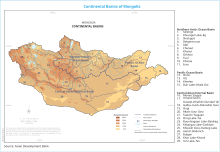Central Asian Internal Drainage Basin (Mongolia)
Appearance

The Central Asian Internal Drainage Basin or Central Asian Inland Basin is the largest of 3 major hydrological basins that cover Mongolia (cf. Arctic Drainage Basin & Pacific Drainage Basin). It is an endorheic basin.[1][2][3] It is further subdivided into local drainage basins.[4]
The basin also includes much of the Western and Central Asia: the watersheds of the Great Lakes Depression, the Valley of Lakes, and the lowlands of the Gobi Desert. It is separated from the other two basins by the ridges of the Khangai Mountains and Khentii Mountains. The Khentii Mountains also separate Arctic and Pacific basins within Mongolia.
See also
References
- ^ Ayurin Dulmaa, "Mongolian Limnology and Ichthyology" in: "Mongolia Today: Science, Culture, Environment and Development" (2002) ISBN 0-7007-1598-3
- ^ Batnasan, N. "Freshwater Issues in Mongolia" (PDF). Proceeding of the National Seminar on IRBM in Mongolia, 24- 25 Sept. 2003, Ulaanbaatar. WWF.
- ^ "Central Asian Inland Basin". Archived from the original on 2007-12-20.
Bulgan River The rivers Bulgan, Uench and Bodonch, with their sources in the southernmost face of the Mongol Altai Mountains, are included in the blind drainage basin of the Central Asia. Other rivers including the Buyant, Khovd, Tsenkher, Sagsai and Sogoog with its tributary rivers, which rise from the north of the Mongol Altai Mountains, are included in the Central Asian blind drainage basin. Khovd River It takes its source from the northern side of the Mongol Altai Mountains and runs into the Lakes Khoton and Khorgon. Its largest tributaries are Tsagaan Khovd and Khar Khovd and it is 593 kilometres long. Zavkhan River It takes its source from the southern face of the Otgontenger Mountain the highest peak of the Khangai Mountain range. The river begins to flow from the confluence of rivers Buyant and Shar Us. The Zavkhan flows by the western side of the Khangai Mountain and flows into the Lake Airag, which is connected with the Lake Khyargas. Its 808 kilometres long and provides most of the tributary flow of the Lake Khyargas.
(quote from Google cache) - ^ OVERVIEW OF MONGOLIA’S WATER RESOURCES SYSTEM AND MANAGEMENT. A COUNTRY WATER SECURITY ASSESSMENT (document linked from here), July 2020
